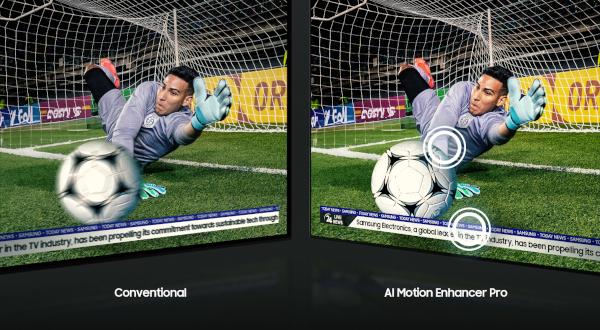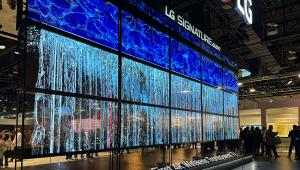AI Front and Center in Samsung’s 2024 TV Lineup

“In today’s hyper-connected era, it’s no longer just about delivering quality visual experiences when it comes to home entertainment,” said SW Yong, president and head of Samsung’s visual display business. “Displays should enhance our lives both on and off the screen. Samsung’s AI screens, powered by on-device AI technology, are designed to be the centerpiece of users’ homes, connecting all compatible devices to offer users a more flexible and diverse lifestyle.”
The company touted the NQ8 AI Gen3 processor at the heart of its 2024 Neo QLED 8K mini-LED models as its most innovative TV processor yet, featuring a neural processing unit (NPU) that is twice as fast as that of its predecessor and with “eight times the neural networks so everything on screen is displayed in crisp detail.”
In addition to overall image enhancement, the power of AI and deep learning is used to upscale low-resolution content to ultra-high 8K resolution, enhance depth by focusing on the parts of a scene to which the eye is naturally drawn so images appear more lifelike, and distinguish between different types of sports to bring clarity to fast moving baseballs, footballs, and other objects (see opening photo).
And then there’s the audio. The Neo QLED 8K models also employ a proprietary AI dialogue booster that separates voices from other sounds to “significantly enhance dialogue and voices on screen” at any volume. The lineup also includes Samsung’s Q-Symphony feature, which synchronizes TV sound with compatible Samsung soundbars and wireless speakers.
Samsung’s 2024 Neo QLED 4K and 8K series TVs will be available in screen sizes up to 98 inches, though the company did not announce pricing or specific screen sizes.
OLED Gets a Refresh
Building on the popularity of last year’s QD (quantum dot)-OLED models, Samsung will deliver a refreshed lineup led by the new flagship S95D series, which boasts its brightest OLED picture to date. The new QD-OLED models also boast AI-enhanced color so pure that it’s “Pantone Validated” for accuracy and “OLED Glare Free” technology, designed to reduce reflections while preserving color accuracy and image sharpness during daytime viewing. Glare is reduced through the combination of a specialized hard-coating screen layer and surface coating pattern.
The S95D series also features a “proprietary picture-quality engine” to help preserve bright whites and deep blacks. The series will include screen sizes up to 77 inches, but no other details were announced.
The company also announced that it is improving and expanding its lifestyle TVs, including The Frame — its top-selling lifestyle model — The Serif, The Sero, The Terrace, and The Freestyle. More than 2,500 works of art from world-renowned museums and galleries are now available for display on The Frame and Samsung has added an art streaming feature that displays hand-selected artworks monthly.
Cutting-edge MicroLED technology in the form of a new Transparent Micro LED screen will also be on display at the Samsung booth when the show opens tomorrow. The modular display, which looks like a piece of glass, uses an extremely small MicroLED chip and precision manufacturing to eliminate seams and light refraction.
In other TV-related news, Samsung also previewed the “world’s first” wireless ultra-short-throw (UST) 8K projector. The Premiere 8K is packed with smart features, including cloud gaming, always-on voice (via a far-field mic), four multi-view screen splits, and a patented "Sound-on-Screen" technology that uses software algorithms to deliver a “more immersive” sound experience from the projector’s built-in speaker.
A More Streamlined, AI-Powered Experience
Samsung has updated its Tizen OS across all models to present content options in a fresh, clean layout and offer a more personalized experience with the ability to create and access different Samsung accounts on 2024 smart TVs. Different members of each household with a Samsung Smart TV can now set up a profile for personalized recommendations and a more customized experience.
The Samsung TV Plus TV service has an updated home screen, which in addition to providing access to hundreds of free TV channels and thousands of shows and movies on demand, offers new options such as Kids and Music to expedite discovery. The service also connects Samsung accounts for seamless connectivity to favorite channels/content and offers suggestions on what to watch.
Samsung has also partnered with gaming accessory provider Performance Designed Products (PDP) to develop the first “Designed for Samsung Gaming Hub” controller, featuring a new wireless controller with a rated battery life of up to 40 hours per charge and a Samsung Gaming Hub launch button.
Picking up on the on-device AI technology theme mentioned earlier, Samsung is aiming to improve the connected experience with Samsung Daily+, a hub for in-home activity that provides a range of services and features — from personal training and telehealth to video calls and remote PC solutions — in one interface.
The 2024 TVs are also said to feature greater compatibility across devices within the ecosystem to enable a more integrated connection between TVs and smartphones or wearable devices for improved customization, accessibility, and convenience. The SmartThings Mobile Plugin, for example, transforms your smartphone into a multi-function remote.
Samsung has also expanded the 360 Audio feature on Galaxy devices to Samsung TVs, allowing compatible Samsung Galaxy Buds to connect with the TV and deliver spatial audio for movies, shows and games.
New 2024 TV models also feature enhanced accessibility features, including the “world's first” on-device TV feature, which uses AI and Optical Character Recognition (OCR) technology to provide a voice guide for subtitles in real-time, and a Relumino Mode that enables people with vision loss to have a better viewing experience without the need for wearable hardware. AI technology is used to rebalance colors and outline the edges of on-screen elements on-the-fly so vision-impaired viewers can see people and objects more clearly.
- Log in or register to post comments




















































